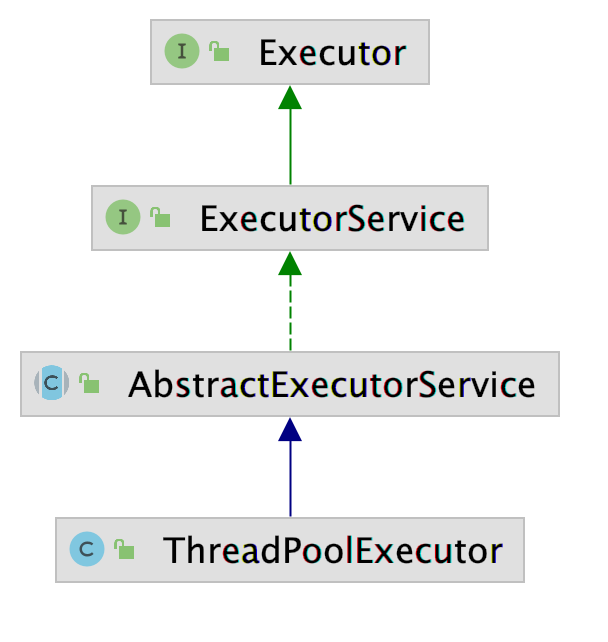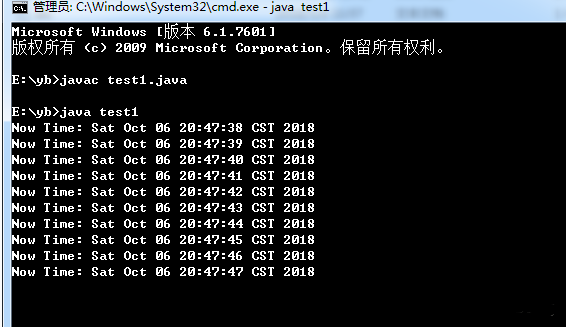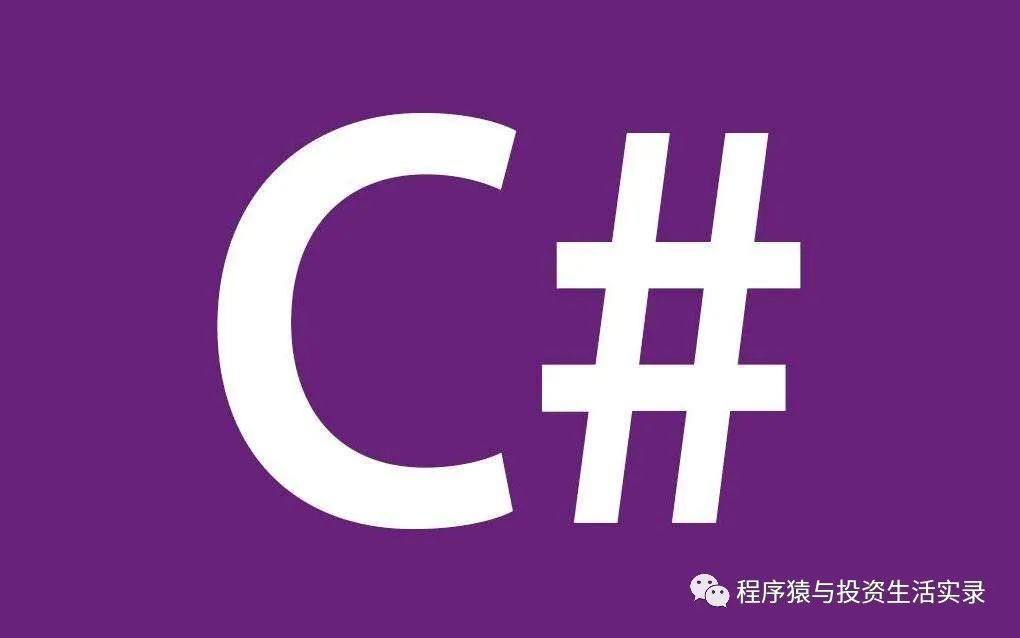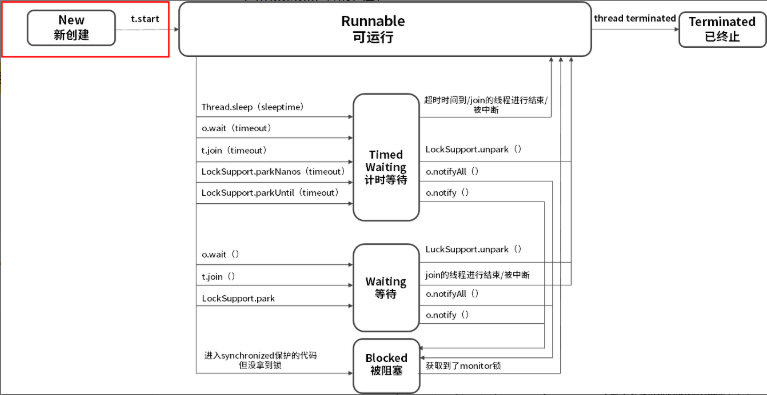停止一個線程意味著在任務處理完任務之前停掉正在做的操作,也就是放棄當前的操作。停止一個線程可以用Thread.stop()方法,但最好不要用它。雖然它確實可以停止一個正在運行的線程,但是這個方法是不安全的,而且是已被廢棄的方法。在java中有以下3種方法可以終止正在運行的線程:
使用退出標志,使線程正常退出,也就是當run方法完成后線程終止。
使用stop方法強行終止,但是不推薦這個方法,因為stop和suspend及resume一樣都是過期作廢的方法。
使用interrupt方法中斷線程。
1. 停止不了的線程
interrupt()方法的使用效果并不像for+break語句那樣,馬上就停止循環。調用interrupt方法是在當前線程中打了一個停止標志,并不是真的停止線程。
public?class?MyThread?extends?Thread?{ ????public?void?run(){ ????????super.run(); ????????for(int?i=0;?i<500000;?i++){ ????????????System.out.println("i="+(i+1)); ????????} ????} } public?class?Run?{ ????public?static?void?main(String?args[]){ ????????Thread?thread?=?new?MyThread(); ????????thread.start(); ????????try?{ ????????????Thread.sleep(2000); ????????????thread.interrupt(); ????????}?catch?(InterruptedException?e)?{ ????????????e.printStackTrace(); ????????} ????} }
輸出結果:
... i=499994 i=499995 i=499996 i=499997 i=499998 i=499999 i=500000
2. 判斷線程是否停止狀態
Thread.java類中提供了兩種方法:
this.interrupted(): 測試當前線程是否已經中斷;
this.isInterrupted(): 測試線程是否已經中斷;
那么這兩個方法有什么圖區別呢?我們先來看看this.interrupted()方法的解釋:測試當前線程是否已經中斷,當前線程是指運行this.interrupted()方法的線程。
public?class?MyThread?extends?Thread?{
????public?void?run(){
????????super.run();
????????for(int?i=0;?i<500000;?i++){
????????????i++;
//????????????System.out.println("i="+(i+1));
????????}
????}
}
public?class?Run?{
????public?static?void?main(String?args[]){
????????Thread?thread?=?new?MyThread();
????????thread.start();
????????try?{
????????????Thread.sleep(2000);
????????????thread.interrupt();
????????????System.out.println("stop?1??"?+?thread.interrupted());
????????????System.out.println("stop?2??"?+?thread.interrupted());
????????}?catch?(InterruptedException?e)?{
????????????e.printStackTrace();
????????}
????}
}
運行結果:
stop?1??false stop?2??false
類Run.java中雖然是在thread對象上調用以下代碼:thread.interrupt(), 后面又使用
System.out.println("stop?1??"?+?thread.interrupted());
System.out.println("stop?2??"?+?thread.interrupted());
來判斷thread對象所代表的線程是否停止,但從控制臺打印的結果來看,線程并未停止,這也證明了interrupted()方法的解釋,測試當前線程是否已經中斷。這個當前線程是main,它從未中斷過,所以打印的結果是兩個false.
如何使main線程產生中斷效果呢?
public?class?Run2?{
????public?static?void?main(String?args[]){
????????Thread.currentThread().interrupt();
????????System.out.println("stop?1??"?+?Thread.interrupted());
????????System.out.println("stop?2??"?+?Thread.interrupted());
????????System.out.println("End");
????}
}
運行效果為:
stop?1??true stop?2??false End
方法interrupted()的確判斷出當前線程是否是停止狀態。但為什么第2個布爾值是false呢? 官方幫助文檔中對interrupted方法的解釋:測試當前線程是否已經中斷。線程的中斷狀態由該方法清除。 換句話說,如果連續兩次調用該方法,則第二次調用返回false。
下面來看一下inInterrupted()方法。
public?class?Run3?{
????public?static?void?main(String?args[]){
????????Thread?thread?=?new?MyThread();
????????thread.start();
????????thread.interrupt();
????????System.out.println("stop?1??"?+?thread.isInterrupted());
????????System.out.println("stop?2??"?+?thread.isInterrupted());
????}
}
運行結果:
stop?1??true stop?2??true
isInterrupted()并為清除狀態,所以打印了兩個true。
3. 能停止的線程--異常法
有了前面學習過的知識點,就可以在線程中用for語句來判斷一下線程是否是停止狀態,如果是停止狀態,則后面的代碼不再運行即可:
public?class?MyThread?extends?Thread?{
????public?void?run(){
????????super.run();
????????for(int?i=0;?i<500000;?i++){
????????????if(this.interrupted())?{
????????????????System.out.println("線程已經終止,?for循環不再執行");
????????????????break;
????????????}
????????????System.out.println("i="+(i+1));
????????}
????}
}
public?class?Run?{
????public?static?void?main(String?args[]){
????????Thread?thread?=?new?MyThread();
????????thread.start();
????????try?{
????????????Thread.sleep(2000);
????????????thread.interrupt();
????????}?catch?(InterruptedException?e)?{
????????????e.printStackTrace();
????????}
????}
}
運行結果:
... i=202053 i=202054 i=202055 i=202056 線程已經終止,?for循環不再執行
上面的示例雖然停止了線程,但如果for語句下面還有語句,還是會繼續運行的。看下面的例子:
public?class?MyThread?extends?Thread?{
????public?void?run(){
????????super.run();
????????for(int?i=0;?i<500000;?i++){
????????????if(this.interrupted())?{
????????????????System.out.println("線程已經終止,?for循環不再執行");
????????????????break;
????????????}
????????????System.out.println("i="+(i+1));
????????}
????????System.out.println("這是for循環外面的語句,也會被執行");
????}
}
使用Run.java執行的結果是:
... i=180136 i=180137 i=180138 i=180139 線程已經終止,?for循環不再執行 這是for循環外面的語句,也會被執行
如何解決語句繼續運行的問題呢? 看一下更新后的代碼:
public?class?MyThread?extends?Thread?{
????public?void?run(){
????????super.run();
????????try?{
????????????for(int?i=0;?i<500000;?i++){
????????????????if(this.interrupted())?{
????????????????????System.out.println("線程已經終止,?for循環不再執行");
????????????????????????throw?new?InterruptedException();
????????????????}
????????????????System.out.println("i="+(i+1));
????????????}
????????????System.out.println("這是for循環外面的語句,也會被執行");
????????}?catch?(InterruptedException?e)?{
????????????System.out.println("進入MyThread.java類中的catch了。。。");
????????????e.printStackTrace();
????????}
????}
}
使用Run.java運行的結果如下:
... i=203798 i=203799 i=203800 線程已經終止,?for循環不再執行 進入MyThread.java類中的catch了。。。 java.lang.InterruptedException ?at?thread.MyThread.run(MyThread.java:13)
4. 在沉睡中停止
如果線程在sleep()狀態下停止線程,會是什么效果呢?
public?class?MyThread?extends?Thread?{
????public?void?run(){
????????super.run();
????????try?{
????????????System.out.println("線程開始。。。");
????????????Thread.sleep(200000);
????????????System.out.println("線程結束。");
????????}?catch?(InterruptedException?e)?{
????????????System.out.println("在沉睡中被停止,?進入catch,?調用isInterrupted()方法的結果是:"?+?this.isInterrupted());
????????????e.printStackTrace();
????????}
????}
}
使用Run.java運行的結果是:
線程開始。。。 在沉睡中被停止,?進入catch,?調用isInterrupted()方法的結果是:false java.lang.InterruptedException:?sleep?interrupted ?at?java.lang.Thread.sleep(Native?Method) ?at?thread.MyThread.run(MyThread.java:12)
從打印的結果來看, 如果在sleep狀態下停止某一線程,會進入catch語句,并且清除停止狀態值,使之變為false。
前一個實驗是先sleep然后再用interrupt()停止,與之相反的操作在學習過程中也要注意:
public?class?MyThread?extends?Thread?{
????public?void?run(){
????????super.run();
????????try?{
????????????System.out.println("線程開始。。。");
????????????for(int?i=0;?i<10000;?i++){
????????????????System.out.println("i="?+?i);
????????????}
????????????Thread.sleep(200000);
????????????System.out.println("線程結束。");
????????}?catch?(InterruptedException?e)?{
?????????????System.out.println("先停止,再遇到sleep,進入catch異常");
????????????e.printStackTrace();
????????}
????}
}
public?class?Run?{
????public?static?void?main(String?args[]){
????????Thread?thread?=?new?MyThread();
????????thread.start();
????????thread.interrupt();
????}
}
運行結果:
i=9998 i=9999 先停止,再遇到sleep,進入catch異常 java.lang.InterruptedException:?sleep?interrupted ?at?java.lang.Thread.sleep(Native?Method) ?at?thread.MyThread.run(MyThread.java:15)
5. 能停止的線程---暴力停止
使用stop()方法停止線程則是非常暴力的。
public?class?MyThread?extends?Thread?{
????private?int?i?=?0;
????public?void?run(){
????????super.run();
????????try?{
????????????while?(true){
????????????????System.out.println("i="?+?i);
????????????????i++;
????????????????Thread.sleep(200);
????????????}
????????}?catch?(InterruptedException?e)?{
????????????e.printStackTrace();
????????}
????}
}
public?class?Run?{
????public?static?void?main(String?args[])?throws?InterruptedException?{
????????Thread?thread?=?new?MyThread();
????????thread.start();
????????Thread.sleep(2000);
????????thread.stop();
????}
}
運行結果:
i=0 i=1 i=2 i=3 i=4 i=5 i=6 i=7 i=8 i=9 Process?finished?with?exit?code?0
6.方法stop()與java.lang.ThreadDeath異常
調用stop()方法時會拋出java.lang.ThreadDeath異常,但是通常情況下,此異常不需要顯示地捕捉。
public?class?MyThread?extends?Thread?{
????private?int?i?=?0;
????public?void?run(){
????????super.run();
????????try?{
????????????this.stop();
????????}?catch?(ThreadDeath?e)?{
????????????System.out.println("進入異常catch");
????????????e.printStackTrace();
????????}
????}
}
public?class?Run?{
????public?static?void?main(String?args[])?throws?InterruptedException?{
????????Thread?thread?=?new?MyThread();
????????thread.start();
????}
}
stop()方法以及作廢,因為如果強制讓線程停止有可能使一些清理性的工作得不到完成。另外一個情況就是對鎖定的對象進行了解鎖,導致數據得不到同步的處理,出現數據不一致的問題。
7. 釋放鎖的不良后果
使用stop()釋放鎖將會給數據造成不一致性的結果。如果出現這樣的情況,程序處理的數據就有可能遭到破壞,最終導致程序執行的流程錯誤,一定要特別注意:
public?class?SynchronizedObject?{
????private?String?name?=?"a";
????private?String?password?=?"aa";
????public?synchronized?void?printString(String?name,?String?password){
????????try?{
????????????this.name?=?name;
????????????Thread.sleep(100000);
????????????this.password?=?password;
????????}?catch?(InterruptedException?e)?{
????????????e.printStackTrace();
????????}
????}
????public?String?getName()?{
????????return?name;
????}
????public?void?setName(String?name)?{
????????this.name?=?name;
????}
????public?String?getPassword()?{
????????return?password;
????}
????public?void?setPassword(String?password)?{
????????this.password?=?password;
????}
}
public?class?MyThread?extends?Thread?{
????private?SynchronizedObject?synchronizedObject;
????public?MyThread(SynchronizedObject?synchronizedObject){
????????this.synchronizedObject?=?synchronizedObject;
????}
????public?void?run(){
????????synchronizedObject.printString("b",?"bb");
????}
}
public?class?Run?{
????public?static?void?main(String?args[])?throws?InterruptedException?{
????????SynchronizedObject?synchronizedObject?=?new?SynchronizedObject();
????????Thread?thread?=?new?MyThread(synchronizedObject);
????????thread.start();
????????Thread.sleep(500);
????????thread.stop();
????????System.out.println(synchronizedObject.getName()?+?"??"?+?synchronizedObject.getPassword());
????}
}
輸出結果:b??aa
由于stop()方法以及在JDK中被標明為“過期/作廢”的方法,顯然它在功能上具有缺陷,所以不建議在程序張使用stop()方法。
8. 使用return停止線程
將方法interrupt()與return結合使用也能實現停止線程的效果:
public?class?MyThread?extends?Thread?{
????public?void?run(){
????????while?(true){
????????????if(this.isInterrupted()){
????????????????System.out.println("線程被停止了!");
????????????????return;
????????????}
????????????System.out.println("Time:?"?+?System.currentTimeMillis());
????????}
????}
}
public?class?Run?{
????public?static?void?main(String?args[])?throws?InterruptedException?{
????????Thread?thread?=?new?MyThread();
????????thread.start();
????????Thread.sleep(2000);
????????thread.interrupt();
????}
}
輸出結果:
... Time:?1467072288503 Time:?1467072288503 Time:?1467072288503 線程被停止了!
不過還是建議使用“拋異常”的方法來實現線程的停止,因為在catch塊中還可以將異常向上拋,使線程停止事件得以傳播。
編輯:黃飛
 電子發燒友App
電子發燒友App



























評論